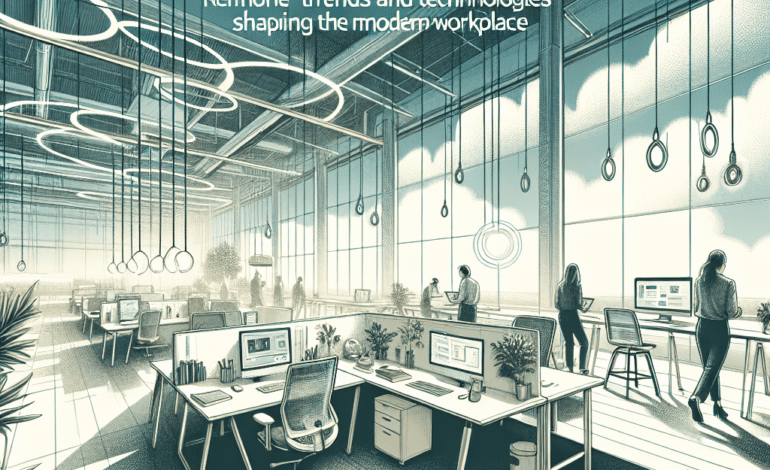The Future of Work: Remote Trends and Technologies Shaping the Modern Workplace

Table of Contents
- Introduction
- Remote Working Trends
- Technologies Enabling Remote Work
- Challenges of Remote Work
- Future Predictions
- Conclusion
- FAQs
Introduction
The workplace is undergoing a significant transformation. As businesses navigate the complexities of the modern world, remote work has emerged as a pivotal component in shaping the future of work. In this article, we will explore the trends and technologies driving this shift, the challenges it presents, and what the future may hold for remote work.
Remote Working Trends
Rise in Remote Jobs
One of the most notable trends has been the substantial rise in remote job opportunities. The COVID-19 pandemic acted as a catalyst, forcing businesses to adapt quickly. What was initially a temporary measure has become a long-term strategy for many organizations. Companies have realized the benefits, including access to a broader talent pool and cost savings on office space.
Flexible Working Hours
The traditional 9-to-5 workday is steadily becoming a relic of the past. Flexible working hours have proven to increase productivity and employee satisfaction. Remote work allows employees to manage their time more effectively, balancing personal and professional commitments. As a result, companies are increasingly adopting flexible schedules to attract and retain top talent.
Gig Economy
The gig economy is another trend gaining momentum. Freelancers, contractors, and part-time workers now make up a significant portion of the workforce. These roles offer employees the flexibility to choose projects that align with their skills and interests. Businesses benefit by accessing specialized skills without the long-term commitment of full-time employment.
Technologies Enabling Remote Work
Video Conferencing Tools
Video conferencing tools like Zoom, Microsoft Teams, and Google Meet have become indispensable. These platforms facilitate virtual meetings, ensuring seamless communication and collaboration regardless of geographical barriers. Features such as screen sharing, virtual backgrounds, and breakout rooms enhance the remote work experience.
Collaboration Platforms
Collaboration platforms such as Slack, Trello, and Asana help teams stay organized and communicate effectively. These tools integrate various functions—chat, tasks, file sharing—into one platform, streamlining workflows and improving team efficiency.
Cloud Computing
Cloud computing has revolutionized the way businesses operate. Services like Google Drive, Dropbox, and Amazon Web Services enable employees to access data and applications from anywhere. This flexibility means that work can continue uninterrupted, even when employees are not in the office.
Cybersecurity
As remote work becomes more prevalent, cybersecurity has emerged as a critical concern. Businesses are investing in technologies like VPNs, multi-factor authentication, and encryption to protect sensitive data. Cybersecurity training for employees is also essential to mitigate risks associated with remote work.
Challenges of Remote Work
Despite its advantages, remote work is not without challenges. Communication barriers, feelings of isolation, and difficulties in maintaining work-life balance are common issues. Employers must proactively address these challenges through regular check-ins, team-building activities, and mental health support to ensure the well-being of their remote workforce.
Future Predictions
The future of work is likely to be a hybrid model that combines remote and in-office work. This approach offers the best of both worlds—flexibility for employees and opportunities for in-person collaboration. Advancements in technology, such as virtual reality (VR) and augmented reality (AR), may further enhance remote work experiences, making virtual interactions feel more real.
Conclusion
The landscape of work is evolving rapidly, and remote work is at the forefront of this transformation. The rise in remote jobs, flexible working hours, and the gig economy are reshaping how we view employment. Technologies like video conferencing, collaboration platforms, and cloud computing are enabling this shift. However, it is crucial to address the challenges associated with remote work to ensure a sustainable and productive future. As businesses and employees adapt to these changes, the future of work promises greater flexibility, efficiency, and opportunities.
FAQs
1. What are the benefits of remote work?
Remote work offers numerous benefits, including increased employee satisfaction, access to a broader talent pool, cost savings on office space, and greater flexibility in managing work-life balance.
2. What technologies are essential for remote work?
Essential technologies for remote work include video conferencing tools (Zoom, Microsoft Teams), collaboration platforms (Slack, Trello), cloud computing services (Google Drive, Dropbox), and cybersecurity measures (VPNs, multi-factor authentication).
3. What are the challenges of remote work?
Common challenges of remote work include communication barriers, feelings of isolation, and difficulties in maintaining work-life balance. Employers must address these issues through regular check-ins, team-building activities, and mental health support.
4. What is the future of remote work?
The future of remote work is likely to be a hybrid model that combines remote and in-office work. Advancements in technology, such as virtual reality (VR) and augmented reality (AR), may further enhance remote work experiences.



